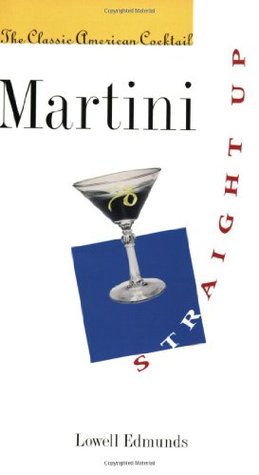Professor Edmunds’ study is welcome for several reasons, not the least of which is that it is the revised edition of his The Silver Bullet: The Martini in American Civilization (1981). That noble and instructive volume was much too good to disappear into oblivion. The centrality of its topic and the originality of his treatment have more than justified this publication, which we may perhaps call the revised standard version.
Lowell Edmunds’ remarkable book is not quite what it seems to be, however. It is not a bartender’s guide or a recipe book, nor is it, in spite of certain celebratory qualities, a guide for snobs. Furthermore, this revised edition transcends its occasion, which is the retro revival of the past decade (and then some) and the image of the Martini as a staple of yuppie steak houses, cigar bars, and so on. The Martini is more important than that, as Edmunds has himself shown.
He certainly more than touches on Martini lore: the provenance of the cocktail, the squabbles about standards, and so on. But I think it is fair to say that, for him, a Martini (as the subject of this disquisition at least) is more than a drink: It is a symbol, and an American one. Edmunds has used various techniques for unfolding the meanings of the Martini, such as examining the history of advertising, analyzing the background of gin and vermouth, and tracking the Martini’s presence in popular culture, for instance in film.
The most immediately gratifying such work is his tracing of the Martini in literature, and I must say that I enjoyed reading the quotations from Jack London, W. Somerset Maugham, F. Scott Fitzgerald, Ernest Hemingway, Evelyn Waugh, Dorothy Parker, J.D. Salinger, John Cheever, John Updike, and others; even more, I relished Edmunds’ comments about them. He has shown that the Martini in literature is not a mere reference but a functioning emblem, a generator of distinctions. For all his erudition, however, I think that Edmunds missed the most poetic and impassioned lines ever inscribed about the Martini, which are from the lips of the alcoholic gunman, Harvey Lovell, in Chapter 18 of Midnight Plus One by Gavin Lyall (1965), at least some of which must be quoted for the record:
Just cold enough to make the glass misty. . . . Not freezing; you can make anything taste as if it might be good by making it freezing. That’s the secret of how to run America, if you want to know it. . . . And no damn olives or onions in it, either. Just a kind of smell like summer.
But even this effusion does not quite speak to the heart of Martini, Straight Up. The book is about more than a mere cocktail—it is about a symbol, as I said. And Edmunds has insisted that the Martini-as-symbol is the Martini we know. To him, the simple messages of the symbol are these: The Martini is American, not European or other; it is urban and urbane, not rural or rustic; it is a high-status drink, not low; it is a man’s drink, not a woman’s; it is optimistic, not pessimistic; it is adult, not juvenile; it is of the past, not the present. The ambiguities of the Martini are more challenging and suggestive of the core of his vision: The Martini is civilized and uncivilized; it unites and separates; it is classic and individual; it is sensitive and tough. Perhaps we would not agree with every one of his theses, but he has nailed them to the door of the clean, well-lighted place of our imagination, and adduced convincing evidence of the paradoxes he has identified.
Edmunds has acknowledged that his mental starting point was in Roland Barthes’ “Wine and Milk” (Mythologies, 1972) and Levi-Strauss’s The Raw and the Cooked (1970). But his work has left structuralism and semiotics behind, in part because of his sense of humor but mostly because of his awareness that the Martini-as-symbol cannot be altogether reduced to formulae. He claims that the Martini embraces the fundamental contradictions of American life, to which we must add that enough Martinis also resolve (or dissolve) those contradictions, or at least let you forget them for a while.
We can only wish that Edmunds’ book were more—even much more—extensive, as it leaves many points to be developed. I do not see, for example, the Martini-as-symbol (and all Martinis are that) as past-oriented. It seems to me a totem of the present, an emblem of the modern. “The Silver Bullet” packs a punch because, after a day at the modern office or in the city, that is what you need. In that sense, the Martini is the civilized antidote to modern experience, one that unleashes uncivilized impulses in a paradoxically hieratic rite that can hardly fail to remind us of ancient religion.
I would have liked to read more, too, about the Martini as a secular Protestant potation, opposed to the wine culture of the Mediterranean/Catholic worlds of Italy, France, and Spain. Within our own nation, the cult of the Martini replaced the great drink of the antebellum South, the Mint Julep, which is arguably both a superior drink and a more American one, and certainly a symbol of other values. To his credit, Edmunds has not assumed that the oxymoronic cocktail lie studies is innocent, any more than a bullet is. He has acknowledged the poisonous possibilities of the Martini and the dead end of alcoholism.
Martini, Straight Up is a stimulating work of cultural criticism and analysis for which the author will be thanked by grateful readers—though one of those readers, at least, has been disappointed by his latitudinarian treatment of that usurper, vodka.
[Martini, Straight Up: The Classic American Cocktail, by Lowell Edmunds (Baltimore: The Johns Hopkins University Press) 153 pp., $24.95]

Leave a Reply